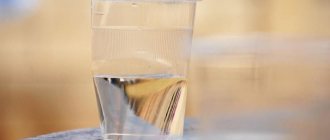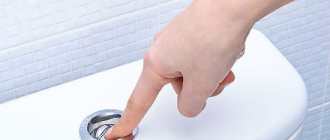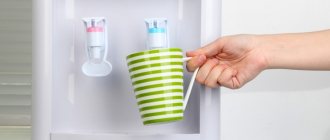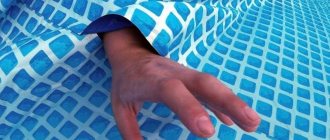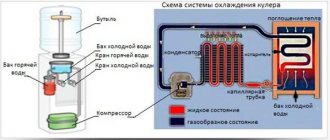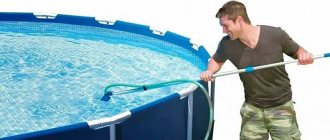Increased rigidity can and should be fought. Therefore, we will consider in detail the existing softening methods, starting with why to soften water, continuing with which method to give preference in a given situation, and ending with what kind of equipment to choose to implement the plan.
Let us immediately note that even the intake from an artesian well is not 100% pure; it still contains impurities (albeit in a lower concentration) that should be gotten rid of. The presence of these undesirable additives can be detected both in laboratory conditions - the most accurate option - and by taste or even visually: by low foaming, the appearance of plaque on the surfaces of plumbing fixtures, and increased consumption of household chemicals.
What is drinking water softening
This is the process of purifying drinking or household liquids from salts by reducing their concentration to acceptable values. In other words, this is a decrease in the degree of rigidity, which can be:
- temporary - with an increased content of magnesium and calcium sediments (bicarbonates);
- constant - with other impurities that do not precipitate into a solid state during boiling, that is, with chlorides, sulfates, nitrates.
Softened water, what is it? In essence, this is a liquid obtained as a result of normalizing the totality of the physical and chemical properties of the medium used, bringing it to recommended and safe for use indicators. Reduces to processing during which unwanted ions and other harmful substances, including nitrogenous and sulfuric acid compounds or pesticides, are removed.
Technical devices
The use of technology reduces time consumption and makes it possible to purify large volumes of liquid.
- Plate filter. The device is built on a non-chemical method of purifying moisture. Installation of a filter in the form of double-sided magnets is carried out on different water pipes. With the help of the resulting magnetic field, salt particles are retained and sent to settling tanks. The water is softened, but its quality does not decrease.
- Filter jug. It gained popularity due to its inexpensive cost and simple device. A replaceable carbon-filled cartridge serves as a barrier to harmful substances. Depending on the frequency of use and water hardness, the filter will need to be changed every two months.
- Device with ion exchange resin. The installation connected to the water supply system contains two containers. In the first tank, the water is purified with resins, and when moving to the second, it is softened with a saline solution. From time to time, the chemical components of the filter need to be replaced, and the unit needs to be connected to the sewer system.
- Filter with membranes. Provides the best results in softening liquids. The water in the device passes under pressure through the filter membranes. Together with softening, the liquid is cleansed of negative bacteria. As a result of specific cleansing, beneficial substances are also removed along with harmful substances. The filter device is expensive and cannot clean large amounts of liquid.
In some cases, you can soften small amounts of liquid using traditional methods. To permanently reduce hardness in large quantities, you will need to purchase and connect special filters to the system.
Need for mitigation
It should be carried out to:
- Remove metallic or bitter taste.
- Eliminate the possibility of sedimentation so that the water can be bottled or used for the preparation of alcoholic beverages, juices, and other food industry products.
- Protect household appliances from scale: excess salt will certainly be deposited on the walls and heating elements of boilers, washing machines, kettles and will first reduce their performance (and therefore increase energy costs for heating by 15-20%), and then cause a breakdown.
- Minimize the consumption of powder and other detergents containing surfactants. It is with surfactants that unwanted impurities will interact, binding them and reducing their effectiveness.
- Get rid of plaque on the surfaces of taps and mixers, toilet cistern, bidet body and other plumbing fixtures, as well as tiles. Deposits not only look unsightly and are difficult to wipe off, but also gradually destroy even hard materials.
- Prevent clogging of industrial systems - scale reduces the throughput and heat transfer coefficient of pipes, gradually clogging them, which results in an increase in fuel consumption for equipment maintenance.
And, most importantly, softening must be carried out to protect your body from the negative effects of excess salts.
Boiling
Heat treatment is the simplest and most accessible method. Ionic bonds of chemical elements are quickly destroyed under the influence of high temperatures, forming a precipitate.
A more complex option is boiling for an hour, followed by daily settling. This method allows you to destroy carbon dioxide vapors, metal salts and chloride compounds.
The disadvantage of this method is the rapid appearance of limescale on the dishes and the deterioration of the organoleptic properties of water.
The dangers of drinking hard water for people
Excess magnesium and calcium negatively affects the condition:
- hair (as a result of washing it) – growth slows down, hair loss increases, dandruff develops, and bald patches appear;
- teeth – they crack and become loose, the enamel chips and carious zones form;
- bones - they become more brittle and susceptible to arthritis and arthrosis.
Constant deposits provoke the formation of stones that disrupt the normal functioning of the kidneys, liver, and intestines. At the same time, gastric motility also decreases: digestion slows down, more digestible food goes into fat reserves, which contributes to rapid weight gain. Over time, cardiovascular diseases also develop: being in a latent form and not manifesting themselves, they turn into pericardium, epicardium, endocardium or myocardium.
Interacting with soap and shampoos, salts precipitate, clogging pores. Hence the feeling of tight and dry skin after showering or washing. The fat layer gradually disappears, oxygen does not pass through the epidermis, which causes redness and other irritations, rashes, pimples, and acne appear. We have to restore microflora and, in general, health with the help of masks, creams and other means, often expensive, although we need to fight not the consequences, but the cause.
Separately, we note that hard water is also harmful to animals: the excess salts it contains accumulate in the bodies of our pets and lead to digestive problems, decreased immunity, and poor-quality increase in volume.
The same dogs or cats lose their appetite, to the point that they completely refuse their previously loved food, get sick more often (and can catch a cold very easily), they gain weight, but this is not muscle or fat, but accumulations of fluid, already in middle age stones appear, which means problems with the kidneys and liver. Cows' milk yield decreases - from 14-20 to 10-14 liters per day - and their mood also deteriorates, which negatively affects the taste of the milk (it becomes bitter).
Tips and tricks
- To soften the water, oxalic acid can be used. It is beneficial for indoor plants, as it fights harmful bacteria, improves microflora and cannot accumulate in the soil. But it has a negative effect on human skin, damaging its cover, so use when washing hair is not recommended.
- To determine water hardness, use the services of a laboratory where samples are brought.
Water quality control is very important, so it is better to use available and optimal methods for this purpose. Such actions will protect your family from negative influences.
What methods of water softening do you prefer? Reveal your secrets in the comments.
Water hardness standards
1.5 m3/h For process water
1.5 m3/h For process water
MBFT-75 Membrane for 75GPD
According to the degree of salt concentration, the working environment can be:
- soft – up to 2 mEq/l;
- normal – 2-4;
- average – 4-6;
- high – more than 6-8 mEq/l.
If we talk about quality standards, in Russia they are such that the limit value for drinking and eating is 7 mEq/l. The World Health Organization is much more principled in this matter and allows an indicator of only 2.5 mEq/l, which, with some amendments, is also relevant for EU countries. Such an excess of WHO recommendations, more than twofold, necessarily plays a negative role in the long term, resulting in the harmful consequences already described.
Advocacy
This method is ideal for large volumes of water, and summer residents and gardeners are best familiar with it. The idea is to fill a tank or bottle, cover it with an awning or gauze to protect it from debris and insects, and leave it for a day or longer. Like melt water, settled water does not lose oxygen and its structure. However, it is not suitable for drinking - only for watering plants. The biggest danger is the proliferation of microorganisms. To avoid this, place a silver earring or ring at the bottom of the bottle (of course, this does not make sense in the case of a 400 liter tank).
The settled water can be drunk if boiled first.
Ion exchange water softeners
Structurally, each of them is a plastic cylinder partially filled with granular polymer resin. The latter acts as a filter, releasing charged sodium particles and absorbing magnesium and calcium. Passing through it, the working environment is purified as a result of a substitution reaction.
AMETHYST - 02 M up to 2 cubic meters/day.
Aeration unit AS-1054 VO-90
Main table dispenser AquaPro 919H/RO (hot and cold water)
Naturally, over time, the ion concentration decreases, and it needs to be restored. To do this, a chloride solution is pumped through a special salt tank. During regeneration, liquid is not supplied, so when you need to organize a continuous intake, install two cylinders at once and turn them on one by one.
How to make water softer at home
There are several options.
For consumption:
- boil - but in this way you will only turn dissolved substances into scale and will not kill all microorganisms (viruses will survive);
- add neutralizer tablets - but at an affordable price, they are characterized by low productivity.
For household needs:
- use acid-based chemicals - but they will not actually reduce the hardness, but will only prevent harmful components from settling on the internal surfaces of the equipment and damaging the heating elements; Therefore, they are suitable for a washing machine or dishwasher, but not for a coffee machine.
A much more practical solution is to use filters, which can be of several types. The simplest of them are:
- Jugs are containers with two reservoirs: liquid is poured into the upper one, which then passes through the cleaning cartridge and enters the lower one, from which it is taken. They are easy to set up and use, but only cope with low hardness (up to 2 mEq/l).
- Flow-through – installed between the points of supply and final consumption, for example, under the sink; pass the working medium through themselves, removing impurities from it due to the active action of the resin they have in stock. Suitable for low and normal hardness (up to 4 mEq/l).
If the task is more complex or larger in scale, more serious equipment is required.
How to soften water from a well
When you take it from the deep layers and in large enough volumes to meet the needs of a country house or cottage, it is worth using one of the following options:
- Ion exchange unit - has two reservoirs, in the first of which there is a viscous substance that replaces charged particles, and in the second - a saline solution. Consistently passing through these containers, the liquid is saturated with sodium and becomes purer.
- Reverse osmosis system - it has membrane filters that pump and maintain the required pressure, facilitating the most effective removal of impurities as the working medium passes through the equipment.
Reasons for the appearance of impurities
Moisture is mineralized as it passes through the soil layers. If there are deposits of limestone, dolomite or gypsum in the region, the liquid receives many impurities. In shallow wells, their concentration changes several times a year. In spring during the flood and in autumn during the rainy season it decreases to a minimum level. In hot weather, when the liquid level in the well drops, the concentration of salts increases. In an artesian well the indicator is stable. Soft water is provided by wells on sand; the highest level of impurities is in sources on calcareous soil.
Is it possible to drink water from a well after a softener?
Yes, and even necessary, because simpler methods simply will not provide the proper degree of purification. The same boiling will not destroy viruses, besides, after it there will be a residue on the walls of the kettle, and some of this scale will still end up in your cup. Tablets are even less effective. The use of chemical reagents is irrelevant in the case of food use of liquid, and if dosages are not observed, it can even be hazardous to health.
All that remains is the filtering equipment. Its modern models can easily cope with a displacement that can meet the needs of an entire country house. And don’t believe the stories that the fence from an artesian well is crystal clear: as we have already mentioned, it also contains impurities, just in smaller quantities, and you also need to get rid of them. We will help you do this: the catalog offers a wide variety of drinking softeners at competitive prices, ranging from the simplest models for apartment sinks to high-performance reverse osmosis stations. Choose, and we will be happy to advise you which option is best suited for your situation.
Magnetic filter
Non-chemical method of softening running water. Some experts have doubts about the appropriateness of its use. The device consists of 2 magnets. The magnetic field they create helps reduce hardness and the amount of various impurities. Not much is known about the effect of water purified by this method on the body. Therefore, such a filter is most often used in boiler rooms.
